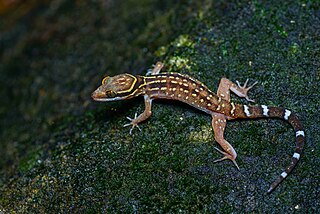
Gekko smithii, commonly known as Smith's green-eyed gecko or the large forest gecko, is a species of lizard in the family Gekkonidae. The species is native to mainland Southeast Asia and Indonesia.

Smith's bent-toed gecko, also known commonly as Malcolm's bow-fingered gecko, is a species of lizard in the family Gekkonidae. The species is endemic to India.
Philautus ingeri is a species of frog in the family Rhacophoridae. It is endemic to northern Borneo and found in Sabah, Sarawak, Brunei, and adjacent northern Kalimantan (Indonesia). Common names Inger's bush frog and Inger's bubble-nest frog have been coined for it. It is named for Robert F. Inger, American zoologist from the Field Museum of Natural History.

Robert Frederick Inger was an American herpetologist. During his lifetime, he wrote numerous books and publications about herpetology. He was also the curator for amphibians and reptiles at the Field Museum in Chicago, Illinois.

Oldham's bow-fingered gecko is a species of lizard in the family Gekkonidae. The species is native to Myanmar and Thailand.
Dibamus ingeri is a species of legless lizard in the family Dibamidae. The species is endemic to the island of Borneo.
The Darmandville bow-fingered gecko is a species of lizard in the family Gekkonidae. The species is endemic to Indonesia.

The Moluccan bow-fingered gecko is a species of lizard in the family Gekkonidae. The species is endemic to the Moluccas in Indonesia.
Dumnui's bent-toed gecko is a species of lizard in the family Gekkonidae. The species is endemic to Thailand.
Eisenman's bent-toed gecko is a species of gecko, a lizard in the family Gekkonidae. The species is endemic to Vietnam.
Huynh's bent-toed gecko, also known commonly as Huynh's bow-fingered gecko, is a species of lizard in the family Gekkonidae. The species is endemic to Vietnam.
Jarujin's forest gecko is a species of lizard in the family Gekkonidae. The species is endemic to Southeast Asia.
The Tenggol Island bent-toed gecko is a species of lizard in the family Gekkonidae. The species is endemic to Tenggol Island in Malaysia.

Boulenger's bow-fingered gecko is a species of gecko, a lizard in the family Gekkonidae. The species is endemic to Papua New Guinea.
Hikida's bow-fingered gecko, also known commonly as Matsui's bent-toed gecko, is a species of lizard in the family Gekkonidae. The species is endemic to the island of Borneo.
Ota's bent-toed gecko is a species of lizard in the family Gekkonidae. The species is endemic to Vietnam.
Cyrtodactylus sadleiri, also known commonly as Sadleir's bow-fingered gecko and the Christmas Island forest gecko, is a species of lizard in the family Gekkonidae. The species is endemic to Christmas Island, Australia.
Stresemann's bent-toed gecko is a species of lizard in the family Gekkonidae. The species is endemic to Malaysia.

Cyrtodactylus sworderi, also known commonly as the Johore bow-fingered gecko, the Kota-tinggi forest gecko, and Sworder's bent-toed gecko, is a species of lizard in the family Gekkonidae. The species is endemic to Malaysia.
Yoshi's bow-fingered gecko s a species of lizard in the family Gekkonidae. The species is endemic to Malaysia.







